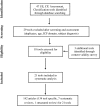Assessment tools and classification systems used for the upper extremity in children with cerebral palsy
- PMID: 21932104
- PMCID: PMC3314769
- DOI: 10.1007/s11999-011-2065-x
Assessment tools and classification systems used for the upper extremity in children with cerebral palsy
Abstract
Background: Clinicians interested in assessment and outcome measurement of upper extremity (UE) function and performance in children with cerebral palsy (CP) must choose from a wide range of tools.
Questions/purposes: We systematically reviewed the literature for UE assessment and classification tools for children with CP to compare instrument content, methodology, and clinical use.
Methods: We searched Health and Psychosocial Instruments (HaPI), US National Library of Medicine (PubMed), and Cumulative Index to Nursing and Allied Health Literature (CINAHL Plus) databases (1937 to the present) to identify UE assessment and outcomes tools. We identified 21 tools for further analysis and searched HaPI, PubMed, CINAHL Plus, and Google Scholar ( http://scholar.google.com/schhp?tab=ws ) databases to identify all validity and reliability studies, systematic reviews, and original references for each of the 21 tools.
Results: The tools identified covered ages birth to adulthood. International Classification of Functioning, Disability and Health domains addressed by these tools included body function, body structure, activities and participation, and environmental factors. Eleven of the tools were patient or family report, seven were clinician-based observations, and three tools could be used in either fashion. All of the tools had published evidence of validity. Nine of the tools were specifically designed for use in subjects with CP. Two of the tools required formal certification before use. Ten of the tools were provided free of charge by the investigators or institution who developed them.
Conclusions: Familiarity with the psychometric and clinometric properties of assessment and classification tools for the UE in children with CP greatly enhances a clinician's ability to select and use these tools in daily clinical practice for both clinical decision-making and assessment of outcome.
Figures
Similar articles
-
Selective Control of the Upper Extremity Scale: validation of a clinical assessment tool for children with hemiplegic cerebral palsy.Dev Med Child Neurol. 2016 Jun;58(6):612-7. doi: 10.1111/dmcn.12949. Epub 2015 Nov 3. Dev Med Child Neurol. 2016. PMID: 26526592
-
The Cerebral Palsy Profile of Health and Function: Upper-Extremity Domain's Sensitivity to Change Following Musculoskeletal Surgery.J Hand Surg Am. 2019 Apr;44(4):274-287. doi: 10.1016/j.jhsa.2018.12.007. Epub 2019 Feb 4. J Hand Surg Am. 2019. PMID: 30733101
-
A systematic review of upper limb activity measures for 5- to 18-year-old children with bilateral cerebral palsy.Aust Occup Ther J. 2019 Oct;66(5):552-567. doi: 10.1111/1440-1630.12600. Epub 2019 Aug 5. Aust Occup Ther J. 2019. PMID: 31385319
-
Upper limb function and deformity in cerebral palsy: a review of classification systems.Dev Med Child Neurol. 2011 Sep;53(9):799-805. doi: 10.1111/j.1469-8749.2011.03953.x. Epub 2011 Mar 24. Dev Med Child Neurol. 2011. PMID: 21434888 Review.
-
Effectiveness of Virtual Reality for Upper Extremity Function and Motor Performance of Children With Cerebral Palsy: A Systematic Review.Am J Occup Ther. 2024 Mar 1;78(2):7802180180. doi: 10.5014/ajot.2024.050374. Am J Occup Ther. 2024. PMID: 38350039
Cited by
-
The Use of ABILHAND-Kids in Children with Unilateral Congenital Below-Elbow Deficiencies and Acquired Amputation: An Italian Cross-Sectional Study.Children (Basel). 2024 Aug 14;11(8):988. doi: 10.3390/children11080988. Children (Basel). 2024. PMID: 39201924 Free PMC article.
-
The Dynamic Thumb-in-Palm Pattern in Children with Spastic Cerebral Palsy and Its Effects on Upper Limb Function.Children (Basel). 2020 Dec 31;8(1):17. doi: 10.3390/children8010017. Children (Basel). 2020. PMID: 33396294 Free PMC article.
-
Botulinum Toxin in the Management of Children with Cerebral Palsy.Paediatr Drugs. 2019 Aug;21(4):261-281. doi: 10.1007/s40272-019-00344-8. Paediatr Drugs. 2019. PMID: 31257556 Free PMC article. Review.
-
Combined intensive therapies at home in spastic unilateral cerebral palsy with high bimanual functional performance. What do they offer? A comparative randomised clinical trial.Ther Adv Chronic Dis. 2021 Aug 12;12:20406223211034996. doi: 10.1177/20406223211034996. eCollection 2021. Ther Adv Chronic Dis. 2021. PMID: 34408823 Free PMC article.
-
Conventional and Virtual Reality Mirror Therapies in Upper Obstetric Brachial Palsy: A Randomized Pilot Study.J Clin Med. 2020 Sep 19;9(9):3021. doi: 10.3390/jcm9093021. J Clin Med. 2020. PMID: 32961793 Free PMC article.
References
-
- Arnould C, Penta M, Renders A, Thonnard JL. ABILHAND-Kids: a measure of manual ability in children with cerebral palsy. Neurology. 2004;63:1045–1952. - PubMed
-
- Bond TG, Fox CM. Applying the Rasch Model. Fundamental Measurement in the Human Sciences. Mahway, NJ: Lawrence Erlbaum; 2001.
-
- Cusick A, McIntyre S, Novak I, Lannin N, Lowe K. A comparison of goal attainment scaling and the Canadian Occupational Performance Measure for paediatric rehabilitation research. Pediatr Rehabil. 2006;9:149–157. - PubMed
Publication types
MeSH terms
LinkOut - more resources
Full Text Sources
Medical
Miscellaneous


